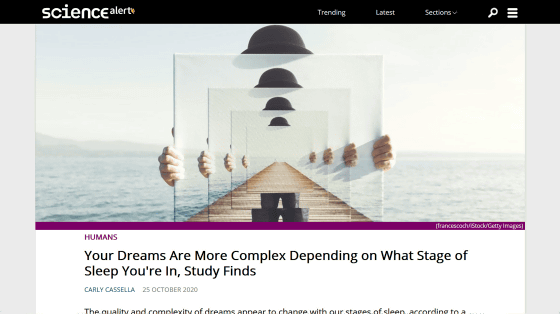Research results show that 'contents of dreams to see' are different between REM sleep and non-REM sleep

Some of the dreams you have while you sleep have a clear scene with a story that looks like a movie, while others have no context, such as a short movie that captures a moment. A new study that analyzed the content of dreams that people asked and heard immediately after waking up showed that the difference between
Structural differences between REM and non-REM dream reports assessed by graph analysis
https://journals.plos.org/plosone/article?id=10.1371/journal.pone.0228903
Word graph analysis confirms that dream report structure varies according to sleep stage | AGSTRUCTNCIA FAPESP
https://agencia.fapesp.br/word-graph-analysis-confirms-that-dream-report-structure-varies-according-to-sleep-stage/34395/
Your Dreams Are More Complex Depending on What Stage of Sleep You're In, Study Finds
https://www.sciencealert.com/the-complexity-of-our-dreams-changes-with-our-stage-of-sleep-reveals-analysis

In the 20th century, it was said that 'I dream only during REM sleep', but in recent years it has been known that I
The content of dreams that occur during REM sleep and non-REM sleep is investigated by forcing people in each sleep stage and asking, 'What kind of dream did you have now?' In some studies , those who woke up during REM sleep generally tended to report 'brilliant, elaborate, emotional, story-like dreams,' while those who woke up during non-REM sleep. It has been shown that they do not remember much about their dreams and tend to be more thought-like than stories.
However, all of the survey results are based on the subjective reports of the subjects, and quantitative measurements have not been made regarding the difference in dreams depending on the stage of sleep. Therefore, a research team composed of researchers from Brazil, South Africa, and Germany developed a tool to graph the words that the subjects explained about their dreams, and objectively explained the contents of their dreams by suppressing sentence length and language bias. I did a study to analyze.

The research team used data from a dream interview survey of 22 university students conducted at the University of Cape Town in South Africa in 2013. In this study, subjects were asked to sleep in a room in the laboratory for several days, and while observing the subject's sleep stage, they woke up in either REM sleep or non-REM sleep, and the dream they had just dreamed of. To hear about the content. The subject's sleep stage was diagnosed based on brain waves and eye movements.
A total of 198 awakenings and interviews were conducted throughout the experiment, of which 146 were successful in listening to the content of the dream. Based on this data, the research team excluded 13 cases where the total number of words in the report was less than 30, and extracted a total of 133 'dream reports during REM sleep or non-REM sleep'. Did.
Previous studies have relied on analyzing the meaning of words reported by subjects, but in this study, words are graphed and the connections between each word are analyzed. Then, dreams during REM sleep were much more complicated than dreams during non-REM sleep, and there was a tendency for each word to be more connected, regardless of the number of words reported. In contrast, dreams during NREM sleep were short, unimpressive, and more thought-provoking.

The reason why sleep stages are divided into REM sleep and non-REM sleep is not well understood so far. However, as this study suggests, if the content of dreams differs depending on the sleep stage, REM sleep and non-REM sleep play different roles in the body of the organism, and the underlying mechanism may be different. ..
'This study uses graph theory to make reports of dreams during REM sleep more structurally linked than reports of dreams during non-REM sleep,' said Joshua Martin, lead author of the paper. This is the first study that showed that. '
'We didn't analyze the meaning of the words, we're dealing with the methods they said, not what they said,' said Natalia Mota, a research team. He argued that the measurement had a different meaning from the conventional research. By taking an approach based on graph theory rather than meaning, it is possible to avoid language bias and conduct surveys of all kinds of cultures and countries, Mota said.

Related Posts:
in Science, Posted by log1h_ik







